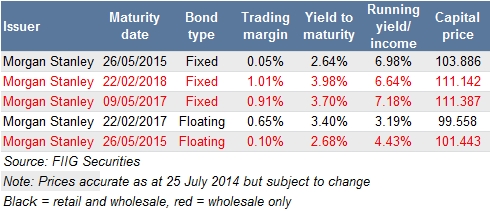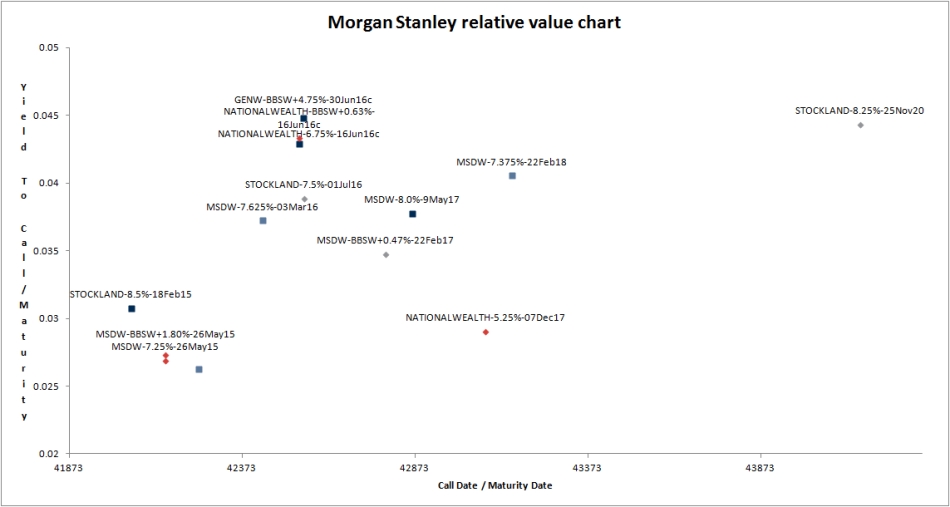by
Elizabeth Moran | Jul 29, 2014
Morgan Stanley’s (MS) net revenue for the second quarter of 2014 was USD8.6bn was lower than a strong seasonal 1Q14, but improved over the 2Q13 result of USD8.5bn.
All three divisions (Institutional Securities, Wealth Management and Investment Management) performed well but the stand-out was Wealth Management with a record value of assets under management of USD2 trillion and a pre-tax profit margin of 21%.
MS continues to work through its restructure and the cost cutting measures it has implemented, and this quarter saw a sharp rise in net income to USD1.9bn for the quarter compared to USD980m for 2Q13.
Other points to note:
- Assets on the balance sheet of USD827bn (USD833bn Year End 2013)
- Risk weighted assets USD423bn (USD389bn YE13)
- Deposits USD118bn (USD112bn YE13)
- Long term debt USD149bn (USD154bn YE13)
- Common Equity Tier 1 ratio (estimated under Basel III) 13.8% (12.8% YE13)
The bank continues to strengthen and we have no concerns from a credit perspective. Longer term holders of fixed rate MS bonds should be sitting on healthy profits if they bought them when we first recommended them a few years ago. The question remains of the possibility of further upside which we view as limited given the current low trading margins and yields of the AUD bonds.
The MS bonds due to mature in 2015 have very low yields to maturity of under 3%, while the longer dated fixed rate bonds show higher yields to maturity, but they are still lower than similar rated securities (see Table 1 and Figure 1 below).
Any remaining investors should consider taking profits and switching into bonds such as Genworth and National Wealth subordinated debt, which have similar credit ratings, shorter times to likely maturity at the first call date and higher yields.

Table 1

Source: FIIG Securities
Figure 1
Key terms
Call date
The date prior to maturity on which a callable bond may be redeemed by the issuer. If the issuer determines there is a benefit to refinancing the issue, the bond may be redeemed on the call date, at par, or at a small premium to par depending on the terms of the call option.
Running yield
Running yield uses the current price of a bond instead of its face value and represents the return an investor would expect if he or she purchased a bond and held it for a year. It is calculated by dividing the coupon by the market price.

Trading margin
The expected return earned on a floating rate security in addition to that security’s reference rate.
Yield to maturity
The return an investor will receive if they buy a bond and hold the bond to maturity. It is the annualised return based on all coupon payments plus the face value or the market price if it was purchased on a secondary market. Yield to maturity thus includes any gain or loss if the security was purchased at a discount (below face value) or premium (above face value). It refers to the interest or dividends received from a security and is usually expressed annually or semi-annually as a percentage based on the investment’s cost, its current market value or its face value. Bond yields may be quoted either as an absolute rate or as a margin to the interest rate swap rate for the same maturity. It is a useful indicator of value because it allows for direct comparison between different types of securities with various maturities and credit risk. Note that the calculation makes the assumption that all coupon payments can be reinvested at the yield to maturity rate. Also, the yield and coupon are different.
Copyright The contents of this document are copyright. Other than under the Copyright Act 1968 (Cth), no part of it may be reproduced or distributed to a third party without FIIG’s prior written permission other than to the recipient’s accountants, tax advisors and lawyers for the purpose of the recipient obtaining advice prior to making any investment decision. FIIG asserts all of its intellectual property rights in relation to this document and reserves its rights to prosecute for breaches of those rights.
Disclaimer Certain statements contained in the information may be statements of future expectations and other forward-looking statements. These statements involve subjective judgement and analysis and may be based on third party sources and are subject to significant known and unknown uncertainties, risks and contingencies outside the control of the company which may cause actual results to vary materially from those expressed or implied by these forward looking statements. Forward-looking statements contained in the information regarding past trends or activities should not be taken as a representation that such trends or activities will continue in the future. You should not place undue reliance on forward-looking statements, which speak only as of the date of this report. Opinions expressed are present opinions only and are subject to change without further notice.
No representation or warranty is given as to the accuracy or completeness of the information contained herein. There is no obligation to update, modify or amend the information or to otherwise notify the recipient if information, opinion, projection, forward-looking statement, forecast or estimate set forth herein, changes or subsequently becomes inaccurate.
FIIG shall not have any liability, contingent or otherwise, to any user of the information or to third parties, or any responsibility whatsoever, for the correctness, quality, accuracy, timeliness, pricing, reliability, performance or completeness of the information. In no event will FIIG be liable for any special, indirect, incidental or consequential damages which may be incurred or experienced on account of the user using information even if it has been advised of the possibility of such damages.
FIIG provides general financial product advice only. As a result, this document, and any information or advice, has been provided by FIIG without taking account of your objectives, financial situation and needs. Because of this, you should, before acting on any advice from FIIG, consider the appropriateness of the advice, having regard to your objectives, financial situation and needs. If this document, or any advice, relates to the acquisition, or possible acquisition, of a particular financial product, you should obtain a product disclosure statement relating to the product and consider the statement before making any decision about whether to acquire the product. Neither FIIG, nor any of its directors, authorised representatives, employees, or agents, makes any representation or warranty as to the reliability, accuracy, or completeness, of this document or any advice. Nor do they accept any liability or responsibility arising in any way (including negligence) for errors in, or omissions from, this document or advice. Any reference to credit ratings of companies, entities or financial products must only be relied upon by a ‘wholesale client’ as that term is defined in section 761G of the Corporations Act 2001 (Cth). FIIG strongly recommends that you seek independent accounting, financial, taxation, and legal advice, tailored to your specific objectives, financial situation or needs, prior to making any investment decision. FIIG does not make a market in the securities or products that may be referred to in this document. A copy of FIIG’s current Financial Services Guide is available at www.fiig.com.au/fsg.
The FIIG research analyst certifies that any views expressed in this document accurately reflect their views about the companies and financial products referred to in this document and that their remuneration is not directly or indirectly related to the views of the research analyst. This document is not available for distribution outside Australia and New Zealand and may not be passed on to any third party without the prior written consent of FIIG. FIIG, its directors and employees and related parties may have an interest in the company and any securities issued by the company and earn fees or revenue in relation to dealing in those securities.